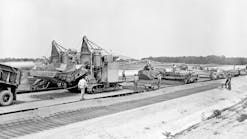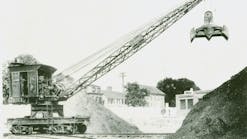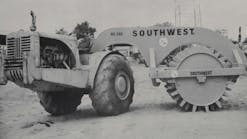Last month, we took a look at the use of large draglines, such as walking draglines, in heavy construction applications. The photo above shows another example of these machines, along with a lot more.
Taken in late 1934 or 1935, the photo shows the site development work for the spillway section of Bonneville Dam. Located 40 miles east of Portland, Ore., on the Columbia River, the dam was the second to be completed on the main stem of the river; Rock Island Dam, downstream from Wenatchee, Wash., was completed in 1933, the year before contracts for Bonneville were awarded. Bradford Island separates the spillway dam (north of the island) from the powerhouse and navigation lock (south of the island).
The spillway dam was built by the Columbia Construction Co. joint venture, comprised of Utah Construction Co., Morrison-Knudsen, Henry J. Kaiser, MacDonald & Kahn, and Bechtel Corp. These five firms, along with Pacific Bridge Co. and J. F. Shea, formed Six Companies, Inc., which built Boulder (later Hoover) Dam. The anomaly of seven contractors forming the “Six Companies” resulted by Kaiser and Bechtel entering the venture as a single entity. The participants in the Six Companies venture subsequently teamed up in various combinations on numerous major projects. Excavation was sublet to the up-and-coming California contractor, Guy F. Atkinson Co.
Although some details are sketchy in this R. G. LeTourneau, file photo, machines and activity shown include:
- Unidentified barge-mounted derrick (distant left)
- Unidentified dredge (immediate right of the derrick)
- Bucyrus-Monighan 8-cubic-yard walking dragline loading spoil from the dam’s foundation into 25-cubic-yard LeTourneau “Buggy” wagons (with positive ejection) pulled by Cat Diesel Seventy-Five crawler tractors
- What appears to be another barge-mounted derrick (behind the dragline)
- Another of the eight Buggy-wagon/Cat crawler combinations discharging its load (foreground)
- What is probably a Marion electric-powered crane and a second, unidentified crane on the cofferdam.
The dam was completed in 1937. A second powerhouse was constructed north of the spillway dam between 1974 and 1981, and a larger navigation lock was completed in 1993. The complex was designated as a National Historic Landmark in 1987.
The Historical Construction Equipment Association (HCEA) is a 501(c)3 nonprofit organization dedicated to preserving the history of the construction, dredging, and surface-mining equipment industries. With more than 4,000 members in 25 countries, our activities include publication of a quarterly educational magazine, Equipment Echoes; operation of the National Construction Equipment Museum and archives in Bowling Green, Ohio; and hosting an annual working exhibition of restored construction equipment. Our 2017 show will be November 3-5 at the Ederville Train and Tractor Show, Carthage, N.C.. Individual memberships within the U.S. and Canada are $35 for one year, $66.95 for two years, $99.95 for three years, and $45.00 US elsewhere. We seek to develop relationships in the equipment manufacturing industry, and we offer a college scholarship for engineering and construction management students. Information is available at www.hcea.net, or by calling 419.352.5616 or e-mailing [email protected]. Information about the project described in this column is from the July 1967, issue of Roads & Streets magazine.





